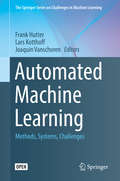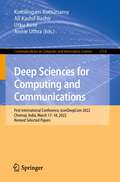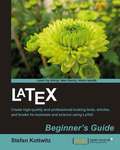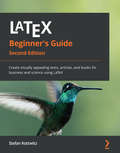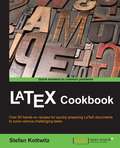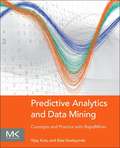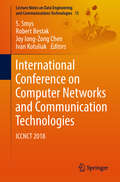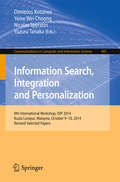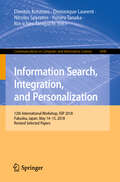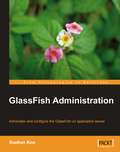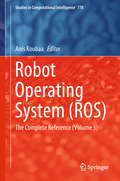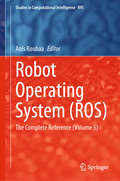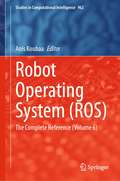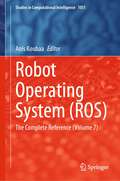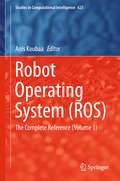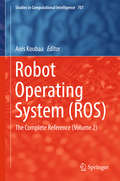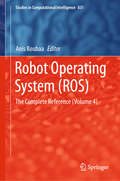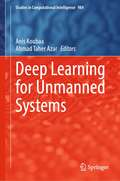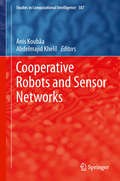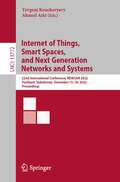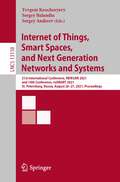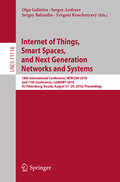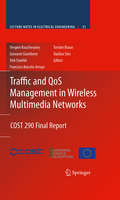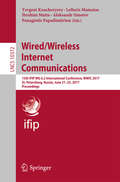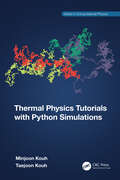- Table View
- List View
Automated Machine Learning: Methods, Systems, Challenges (The Springer Series on Challenges in Machine Learning)
by Lars Kotthoff Joaquin Vanschoren Frank HutterThis open access book presents the first comprehensive overview of general methods in Automated Machine Learning (AutoML), collects descriptions of existing systems based on these methods, and discusses the first series of international challenges of AutoML systems. The recent success of commercial ML applications and the rapid growth of the field has created a high demand for off-the-shelf ML methods that can be used easily and without expert knowledge. However, many of the recent machine learning successes crucially rely on human experts, who manually select appropriate ML architectures (deep learning architectures or more traditional ML workflows) and their hyperparameters. To overcome this problem, the field of AutoML targets a progressive automation of machine learning, based on principles from optimization and machine learning itself. This book serves as a point of entry into this quickly-developing field for researchers and advanced students alike, as well as providing a reference for practitioners aiming to use AutoML in their work.
Deep Sciences for Computing and Communications: First International Conference, IconDeepCom 2022, Chennai, India, March 17–18, 2022, Revised Selected Papers (Communications in Computer and Information Science #1719)
by Kottilingam Kottursamy Ali Kashif Bashir Utku Kose Annie UthraThis book constitutes selected papers presented during the First International Conference on Deep Sciences for Computing and Communications, IconDeepCom 2022, held in Chennai, India, in March 2022.The 27 papers presented were thoroughly reviewed and selected from 97 submissions. They are organized in topical sections as follows: classification and regression problems for communication paradigms; deep learning and vision computing; deep- recurrent neural network (RNN) for industrial informatics; extended AI for heterogeneous edge.
LaTeX Beginner's Guide
by Stefan KottwitzPacked with fully explained examples, LaTeX Beginner's Guide is a hands-on introduction quickly leading a novice user to professional-quality results. If you are about to write mathematical or scientific papers, seminar handouts, or even plan to write a thesis, then this book offers you a fast-paced and practical introduction. Particularly during studying in school and university you will benefit much, as a mathematician or physicist as well as an engineer or a humanist. Everybody with high expectations who plans to write a paper or a book will be delighted by this stable software.
LaTeX Beginner's Guide: Create visually appealing texts, articles, and books for business and science using LaTeX, 2nd Edition
by Stefan KottwitzHarness the power of LaTeX and its wide range of features to create professional-looking text, articles, and books with both online and offline capabilities of LaTeXKey FeaturesGet a hands-on introduction to LaTeX using fully explained examples to advance from beginner to LaTeX professional quicklyWrite impressive mathematical, scientific, and business papers or theses using LaTeXExplore LaTeX onlineBook DescriptionLaTeX is high-quality open source typesetting software that produces professional prints and PDF files. It's a powerful and complex tool with a multitude of features, so getting started can be intimidating. However, once you become comfortable with LaTeX, its capabilities far outweigh any initial challenges, and this book will help you with just that! The LaTeX Beginner's Guide will make getting started with LaTeX easy. If you are writing mathematical, scientific, or business papers, or have a thesis to write, this is the perfect book for you. With the help of fully explained examples, this book offers a practical introduction to LaTeX with plenty of step-by-step examples that will help you achieve professional-level results in no time. You'll learn to typeset documents containing tables, figures, formulas, and common book elements such as bibliographies, glossaries, and indexes, and go on to manage complex documents and use modern PDF features. You'll also get to grips with using macros and styles to maintain a consistent document structure while saving typing work. By the end of this LaTeX book, you'll have learned how to fine-tune text and page layout, create professional-looking tables, include figures, present complex mathematical formulas, manage complex documents, and benefit from modern PDF features.What you will learnMake the most of LaTeX's powerful features to produce professionally designed textsDownload, install, and set up LaTeX and use additional styles, templates, and toolsTypeset math formulas and scientific expressions to the highest standardsUnderstand how to include graphics and work with figures and tablesDiscover professional fonts and modern PDF featuresWork with book elements such as bibliographies, glossaries, and indexesTypeset documents containing tables, figures, and formulasWho this book is forIf you are about to write mathematical or scientific papers, seminar handouts, or even plan to write a thesis, this book offers you a fast-paced and practical introduction to LaTeX. School and university students will find this easy-to-follow LaTeX guide helpful, as will mathematicians, physicists, engineers, and humanists. Anybody with high expectations from their software will discover how easy it is to leverage LaTeX's high performance for creating documents.
LaTeX Cookbook
by Stefan KottwitzOver 100 hands-on recipes to quickly prepare LaTeX documents of various kinds to solve challenging tasksAbout This BookWork with modern document classes, such as KOMA-Script classesExplore the latest LaTeX packages, including TikZ, pgfplots, and biblatexAn example-driven approach to creating stunning graphics directly within LaTeXWho This Book Is ForIf you already know the basics of LaTeX and you like to get fast, efficient solutions, this is the perfect book for you. If you are an advanced reader, you can use this book's example-driven format to take your skillset to the next level. Some familiarity with the basic syntax of LaTeX and how to use the editor of your choice for compiling is required.What You Will LearnChoose the right document class for your project to customize its featuresUtilize fonts globally and locallyFrame, shape, arrange, and annotate imagesAdd a bibliography, a glossary, and an indexCreate colorful graphics including diagrams, flow charts, bar charts, trees, plots in 2d and 3d, time lines, and mindmapsSolve typical tasks for various sciences including math, physics, chemistry, electrotechnics, and computer scienceOptimize PDF output and enrich it with meta data, annotations, popups, animations, and fill-in fieldsExplore the outstanding capabilities of the newest engines and formats such as XeLaTeX, LuaLaTeX, and LaTeX3In DetailLaTeX is a high-quality typesetting software and is very popular, especially among scientists. Its programming language gives you full control over every aspect of your documents, no matter how complex they are. LaTeX's huge amount of customizable templates and supporting packages cover most aspects of writing with embedded typographic expertise.With this book you will learn to leverage the capabilities of the latest document classes and explore the functionalities of the newest packages.The book starts with examples of common document types. It provides you with samples for tuning text design, using fonts, embedding images, and creating legible tables. Common document parts such as the bibliography, glossary, and index are covered, with LaTeX's modern approach.You will learn how to create excellent graphics directly within LaTeX, including diagrams and plots quickly and easily.Finally, you will discover how to use the new engines XeTeX and LuaTeX for advanced programming and calculating with LaTeX.The example-driven approach of this book is sure to increase your productivity.Style and approachThis book guides you through the world of LaTeX based on over a hundred hands-on examples. These are explained in detail and are designed to take minimal time and to be self-compliant.
Predictive Analytics And Data Mining: Concepts And Practice With Rapidminer
by Vijay Kotu Bala DeshpandePut Predictive Analytics into Action Learn the basics of Predictive Analysis and Data Mining through an easy to understand conceptual framework and immediately practice the concepts learned using the open source RapidMiner tool. Whether you are brand new to Data Mining or working on your tenth project, this book will show you how to analyze data, uncover hidden patterns and relationships to aid important decisions and predictions. Data Mining has become an essential tool for any enterprise that collects, stores and processes data as part of its operations. This book is ideal for business users, data analysts, business analysts, business intelligence and data warehousing professionals and for anyone who wants to learn Data Mining. You'll be able to: 1. Gain the necessary knowledge of different data mining techniques, so that you can select the right technique for a given data problem and create a general purpose analytics process. 2. Get up and running fast with more than two dozen commonly used powerful algorithms for predictive analytics using practical use cases. 3. Implement a simple step-by-step process for predicting an outcome or discovering hidden relationships from the data using RapidMiner, an open source GUI based data mining tool Predictive analytics and Data Mining techniques covered: Exploratory Data Analysis, Visualization, Decision trees, Rule induction, k-Nearest Neighbors, Na ve Bayesian, Artificial Neural Networks, Support Vector machines, Ensemble models, Bagging, Boosting, Random Forests, Linear regression, Logistic regression, Association analysis using Apriori and FP Growth, K-Means clustering, Density based clustering, Self Organizing Maps, Text Mining, Time series forecasting, Anomaly detection and Feature selection. Implementation files can be downloaded from the book companion site at www.LearnPredictiveAnalytics.com Demystifies data mining concepts with easy to understand language Shows how to get up and running fast with 20 commonly used powerful techniques for predictive analysis Explains the process of using open source RapidMiner tools Discusses a simple 5 step process for implementing algorithms that can be used for performing predictive analytics Includes practical use cases and examples
International Conference on Computer Networks and Communication Technologies: Iccnct 2018 (Lecture Notes on Data Engineering and Communications Technologies #15)
by Ivan Kotuliak Joy Iong-Zong Chen Robert Bestak S. SmysThe book features research papers presented at the International Conference on Computer Networks and Inventive Communication Technologies (ICCNCT 2018), offering significant contributions from researchers and practitioners in academia and industry. The topics covered include computer networks, network protocols and wireless networks, data communication technologies, and network security. Covering the main core and specialized issues in the areas of next-generation wireless network design, control, and management, as well as in the areas of protection, assurance, and trust in information security practices, these proceedings are a valuable resource, for researchers, instructors, students, scientists, engineers, managers, and industry practitioners.
Information Search, Integration and Personalization
by Dimitrios Kotzinos Yeow Wei Choong Nicolas Spyratos Yuzuru TanakaThis book constitutes the refereed post-proceedings of the 9th International Workshop on Information Search, Integration and Personalization, ISIP 2014, held in Kuala Lumpur, Malaysia, in October 2014. The 6 revised full papers and one invited papers presented were carefully reviewed and selected from 19 presentations. The papers are organized around the following topics: information search in large data sets (databases, digital libraries, data warehouses); comparison of different information search technologies, approaches, and algorithms; novel approaches to information search; personalized information retrieval and personalized web search; data analytics (data mining, data warehousing); integration of Web-services, knowledge bases, digital libraries; federation of smart objects.
Information Search, Integration, and Personalization: 12th International Workshop, ISIP 2018, Fukuoka, Japan, May 14–15, 2018, Revised Selected Papers (Communications in Computer and Information Science #1040)
by Dimitris Kotzinos Dominique Laurent Nicolas Spyratos Yuzuru Tanaka Rin-Ichiro TaniguchiThis book constitutes the revised selected papers of the 12th International Workshop on Information Search, Integration and Personalization, ISIP 2018, held in Fukuoka, Japan, in May 2018.The volume presents 1 invited paper as well as 7 revised full papers, which were carefully reviewed and selected from 13 papers submitted to these post-conference proceedings. The papers are organized in topical sections on data integration; text and document management; advanced data mining techniques.
GlassFish Administration
by Xuekun KouThis book provides an in-depth tutorial on administering the GlassFish application server. Every chapter starts with a clear discussion of the involved concepts, followed by step-by-step instructions on how to perform the administrative task. Clear illustrations and complete working code examples are used to help you visualize the relevant topics. If you are a Java EE application developer and architect who builds and deploys Java EE, Ruby on Rails, and other supported applications for the GlassFish Application Server, then this book is for you. This book is also very valuable if you are an administrator responsible for maintaining the GlassFish Server runtime. Basic knowledge of Java EE 5 is assumed but you need not have any previous knowledge of GlassFish. Those who already know the basics of GlassFish will still find this book useful as they will gain knowledge of administration tasks.
Robot Operating System: The Complete Reference (Volume 3) (Studies in Computational Intelligence #778)
by Anis KoubaaBuilding on the successful first and second volumes, this book is the third volume of the Springer book on the Robot Operating System (ROS): The Complete Reference. The Robot Operating System is evolving from year to year with a wealth of new contributed packages and enhanced capabilities. Further, the ROS is being integrated into various robots and systems and is becoming an embedded technology in emerging robotics platforms. The objective of this third volume is to provide readers with additional and comprehensive coverage of the ROS and an overview of the latest achievements, trends and packages developed with and for it. Combining tutorials, case studies, and research papers, the book consists of sixteen chapters and is divided into five parts. Part 1 presents multi-robot systems with the ROS. In Part 2, four chapters deal with the development of unmanned aerial systems and their applications. In turn, Part 3 highlights recent work related to navigation, motion planning and control. Part 4 discusses recently contributed ROS packages for security, ROS2, GPU usage, and real-time processing. Lastly, Part 5 deals with new interfaces allowing users to interact with robots. Taken together, the three volumes of this book offer a valuable reference guide for ROS users, researchers, learners and developers alike. Its breadth of coverage makes it a unique resource.
Robot Operating System: The Complete Reference (Volume 5) (Studies in Computational Intelligence #895)
by Anis KoubaaThis book is the fifth volume in the successful book series Robot Operating System: The Complete Reference. The objective of the book is to provide the reader with comprehensive coverage on the Robot Operating System (ROS), which is currently considered to be the primary development framework for robotics applications, and the latest trends and contributing systems. The content is divided into six parts. Pat I presents for the first time the emerging ROS 2.0 framework, while Part II focuses on multi-robot systems, namely on SLAM and Swarm coordination. Part III provides two chapters on autonomous systems, namely self-driving cars and unmanned aerial systems. In turn, Part IV addresses the contributions of simulation frameworks for ROS. In Part V, two chapters explore robotic manipulators and legged robots. Finally, Part VI presents emerging topics in monocular SLAM and a chapter on fault tolerance systems for ROS. Given its scope, the book will offer a valuable companion for ROS users and developers, helping them deepen their knowledge of ROS capabilities and features.
Robot Operating System: The Complete Reference (Volume 6) (Studies in Computational Intelligence #962)
by Anis KoubaaThis book is the sixth volume of the successful book series on Robot Operating System: The Complete Reference. The objective of the book is to provide the reader with comprehensive coverage of the Robot Operating Systems (ROS) and the latest trends and contributed systems. ROS is currently considered as the primary development framework for robotics applications. There are seven chapters organized into three parts. Part I presents two chapters on the emerging ROS 2.0 framework; in particular, ROS 2.0 is become increasingly mature to be integrated into the industry. The first chapter from Amazon AWS deals with the challenges that ROS 2 developers will face as they transition their system to be commercial-grade. The second chapter deals with reactive programming for both ROS1 and ROS. In Part II, two chapters deal with advanced robotics, namely on the usage of robots in farms, and the second deals with platooning systems. Part III provides three chapters on ROS navigation. The first chapter deals with the use of deep learning for ROS navigation. The second chapter presents a detailed tuning guide on ROS navigation and the last chapter discusses SLAM for ROS applications. I believe that this book is a valuable companion for ROS users and developers to learn more ROS capabilities and features.
Robot Operating System: The Complete Reference (Volume 7) (Studies in Computational Intelligence #1051)
by Anis KoubaaThis book is the seventh volume of the successful book series on Robot Operating System: The Complete Reference, which started in 2016. The book's objective is to provide the reader with comprehensive coverage on the Robot Operating Systems (ROS) and the latest trends and contributed systems. ROS has been considered as the primary development framework for robotics applications.There are seven chapters organized into three parts. Part I presents one chapter dealing with ROS2 and presents a tutorial on using the MediaPipe framework with ROS2. In Part II, three chapters present new contributions of ROS frameworks and applications, including micro-ROS, Autonomous 3D Thermal Mapping of Disaster Environments, and Lab-scale Smart Factory Implementation Using ROS. Part III provides contributions on how to use ROS for cooperative robotics behaviors, particularly in platoon applications, in addition to developing new perception and control algorithms with sensing technologies. This book will be a valuable companion for ROS users and developers to learn more about ROS capabilities and features.
Robot Operating System (ROS)
by Anis KoubaaThe objective of this book is to provide the reader with a comprehensive coverage on the Robot Operating Systems (ROS) and latest related systems, which is currently considered as the main development framework for robotics applications. The book includes twenty-seven chapters organized into eight parts. Part 1 presents the basics and foundations of ROS. In Part 2, four chapters deal with navigation, motion and planning. Part 3 provides four examples of service and experimental robots. Part 4 deals with real-world deployment of applications. Part 5 presents signal-processing tools for perception and sensing. Part 6 provides software engineering methodologies to design complex software with ROS. Simulations frameworks are presented in Part 7. Finally, Part 8 presents advanced tools and frameworks for ROS including multi-master extension, network introspection, controllers and cognitive systems. This book will be a valuable companion for ROS users and developers to learn more ROS capabilities and features.
Robot Operating System (ROS)
by Anis KoubaaThe objective of this book is to provide the reader with a comprehensive coverage on the Robot Operating Systems (ROS) and latest related systems, which is currently considered as the main development framework for robotics applications. The book includes twenty-seven chapters organized into eight parts. Part 1 presents the basics and foundations of ROS. In Part 2, four chapters deal with navigation, motion and planning. Part 3 provides four examples of service and experimental robots. Part 4 deals with real-world deployment of applications. Part 5 presents signal-processing tools for perception and sensing. Part 6 provides software engineering methodologies to design complex software with ROS. Simulations frameworks are presented in Part 7. Finally, Part 8 presents advanced tools and frameworks for ROS including multi-master extension, network introspection, controllers and cognitive systems. This book will be a valuable companion for ROS users and developers to learn more ROS capabilities and features.
Robot Operating System: The Complete Reference (Volume 4) (Studies in Computational Intelligence #831)
by Anis KoubaaThis is the fourth volume of the successful series Robot Operating Systems: The Complete Reference, providing a comprehensive overview of robot operating systems (ROS), which is currently the main development framework for robotics applications, as well as the latest trends and contributed systems. The book is divided into four parts: Part 1 features two papers on navigation, discussing SLAM and path planning. Part 2 focuses on the integration of ROS into quadcopters and their control. Part 3 then discusses two emerging applications for robotics: cloud robotics, and video stabilization. Part 4 presents tools developed for ROS; the first is a practical alternative to the roslaunch system, and the second is related to penetration testing. This book is a valuable resource for ROS users and wanting to learn more about ROS capabilities and features.
Deep Learning for Unmanned Systems (Studies in Computational Intelligence #984)
by Anis Koubaa Ahmad Taher AzarThis book is used at the graduate or advanced undergraduate level and many others. Manned and unmanned ground, aerial and marine vehicles enable many promising and revolutionary civilian and military applications that will change our life in the near future. These applications include, but are not limited to, surveillance, search and rescue, environment monitoring, infrastructure monitoring, self-driving cars, contactless last-mile delivery vehicles, autonomous ships, precision agriculture and transmission line inspection to name just a few. These vehicles will benefit from advances of deep learning as a subfield of machine learning able to endow these vehicles with different capability such as perception, situation awareness, planning and intelligent control. Deep learning models also have the ability to generate actionable insights into the complex structures of large data sets. In recent years, deep learning research has received an increasing amount of attention from researchers in academia, government laboratories and industry. These research activities have borne some fruit in tackling some of the challenging problems of manned and unmanned ground, aerial and marine vehicles that are still open. Moreover, deep learning methods have been recently actively developed in other areas of machine learning, including reinforcement training and transfer/meta-learning, whereas standard, deep learning methods such as recent neural network (RNN) and coevolutionary neural networks (CNN). The book is primarily meant for researchers from academia and industry, who are working on in the research areas such as engineering, control engineering, robotics, mechatronics, biomedical engineering, mechanical engineering and computer science. The book chapters deal with the recent research problems in the areas of reinforcement learning-based control of UAVs and deep learning for unmanned aerial systems (UAS)The book chapters present various techniques of deep learning for robotic applications. The book chapters contain a good literature survey with a long list of references.The book chapters are well written with a good exposition of the research problem, methodology, block diagrams and mathematical techniques.The book chapters are lucidly illustrated with numerical examples and simulations.The book chapters discuss details of applications and future research areas.
Cooperative Robots and Sensor Networks (Studies in Computational Intelligence #507)
by Anis Koubâa Abdelmajid KhelilMobile robots and Wireless Sensor Networks (WSNs) have enabled great potentials and a large space for ubiquitous and pervasive applications. Robotics and WSNs have mostly been considered as separate research fields and little work has investigated the marriage between these two technologies. However, these two technologies share several features, enable common cyber-physical applications and provide complementary support to each other. The primary objective of book is to provide a reference for cutting-edge studies and research trends pertaining to robotics and sensor networks, and in particular for the coupling between them. The book consists of five chapters. The first chapter presents a cooperation strategy for teams of multiple autonomous vehicles to solve the rendezvous problem. The second chapter is motivated by the need to improve existing solutions that deal with connectivity prediction, and proposed a genetic machine learning approach for link-quality prediction. The third chapter presents an architecture for indoor navigation using an Android smartphone for guiding a variety of users, from sighted to the visually impaired, to their intended destination. In chapter four, the authors deal with accurate prediction modeling of ocean currents for underwater glider navigation. In chapter five, the authors discuss the challenges and limitations of RSS-based localization mechanisms and propose, EasyLoc, an autonomous and practical RSS-based localization technique that satisfies ease of deployment and implementation.
Internet of Things, Smart Spaces, and Next Generation Networks and Systems: 22nd International Conference, NEW2AN 2022, Tashkent, Uzbekistan, December 15–16, 2022, Proceedings (Lecture Notes in Computer Science #13772)
by Yevgeni Koucheryavy Ahmed AzizThis book constitutes the joint refereed proceedings of the 22nd International Conference on Internet of Things, Smart Spaces, and Next Generation Networks and Systems, NEW2AN 2022, held in Tashkent, Uzbekistan, in December 2022.The 58 regular papers presented in this volume were carefully reviewed and selected from 282 submissions. The papers of NEW2AN address various aspects of next-generation data networks, while special attention is given to advanced wireless networking and applications. In particular, the authors have demonstrated novel and innovative approaches to performance and efficiency analysis of 5G and beyond systems, employed game-theoretical formulations, advanced queuing theory, and machine learning. It is also worth mentioning the rich coverage of the Internet of Things, optics, signal processing, as well as digital economy and business aspects.
Internet of Things, Smart Spaces, and Next Generation Networks and Systems: 21st International Conference, NEW2AN 2021, and 14th Conference, ruSMART 2021, St. Petersburg, Russia, August 26–27, 2021, Proceedings (Lecture Notes in Computer Science #13158)
by Yevgeni Koucheryavy Sergey Balandin Sergey AndreevThis book constitutes the joint refereed proceedings of the 21st International Conference on Next Generation Teletraffic and Wired/Wireless Advanced Networks and Systems, NEW2AN 2021, and the 14th Conference on Internet of Things and Smart Spaces, ruSMART 2021. The conference was held virtually due to the COVID-19 pandemic. The 41 revised full papers presented were carefully reviewed and selected from 118 submissions.
Internet of Things, Smart Spaces, and Next Generation Networks and Systems: 18th International Conference, NEW2AN 2018, and 11th Conference, ruSMART 2018, St. Petersburg, Russia, August 27–29, 2018, Proceedings (Lecture Notes in Computer Science #11118)
by Yevgeni Koucheryavy Sergey Balandin Sergey Andreev Olga GalininaThis book constitutes the joint refereed proceedings of the 18th International Conference on Next Generation Wired/Wireless Advanced Networks and Systems, NEW2AN 2018, the 11th Conference on Internet of Things and Smart Spaces, ruSMART 2018. The 64 revised full papers presented were carefully reviewed and selected from 186 submissions. The papers of NEW2AN focus on advanced wireless networking and applications; lower-layer communication enablers; novel and innovative approaches to performance and efficiency analysis of ad-hoc and machine-type systems; employed game-theoretical formulations, Markov chain models, and advanced queuing theory; grapheme and other emerging material, photonics and optics; generation and processing of signals; and business aspects. The ruSMART papers deal with fully-customized applications and services.
Traffic and QoS Management in Wireless Multimedia Networks
by Yevgeni Koucheryavy Torsten Braun Vasilios Siris Dirk Staehle Giovanni Giambene Francisco Barcelo-Arroyo"Traffic and QoS Management in Wireless Multimedia Networks" presents the scientific contributions of the European COST 290 project. Traffic and QoS in wireless networks are addressed from a range of perspectives, including electrical engineering, software development, and networking. This book presents state-of-the-art information, reviews open issues, and suggests directions for future research.
Wired/Wireless Internet Communications
by Yevgeni Koucheryavy Lefteris Mamatas Ibrahim Matta Aleksandr Ometov Panagiotis PapadimitriouWelcome to the 3rd International Conference on Wired/Wireless Internet C- munications (WWIC). After a successful start in Las Vegas and a selective c- ference in Germany, this year s WWIC demonstrated the event s maturity. The conference was supported by several sponsors, both international and local, and became the o?cial venue for COST Action 290. That said, WWIC has now been established as a top-quality conference to promote research on the convergence of wired and wireless networks. This year we received 117 submissions, which allowed us to organize an - citing program with excellent research results, but required more e?ort from the 54 members of the international Program Committee and the 51 additional reviewers. For each of the 117 submitted papers we asked three independent - viewers to provide their evaluation. Based on an online ballot phase and a TPC meeting organized in Colmar (France), we selected 34 high-quality papers for presentation at the conference. Thus, the acceptance rate for this year was 29%. "
Thermal Physics Tutorials with Python Simulations (Series in Computational Physics)
by Minjoon Kouh Taejoon KouhThis book provides an accessible introduction to thermal physics with computational approaches that complement the traditional mathematical treatments of classical thermodynamics and statistical mechanics. It guides readers through visualizations and simulations in the Python programming language, helping them to develop their own technical computing skills (including numerical and symbolic calculations, optimizations, recursive operations, and visualizations). Python is a highly readable and practical programming language, making this book appropriate for students without extensive programming experience. This book may serve as a thermal physics textbook for a semester-long undergraduate thermal physics course or may be used as a tutorial on scientific computing with focused examples from thermal physics. This book will also appeal to engineering students studying intermediate-level thermodynamics as well as computer science students looking to understand how to apply their computer programming skills to science. Key features Major concepts in thermal physics are introduced cohesively through computational and mathematical treatments. Computational examples in Python programming language guide students on how to simulate and visualize thermodynamic principles and processes for themselves.
